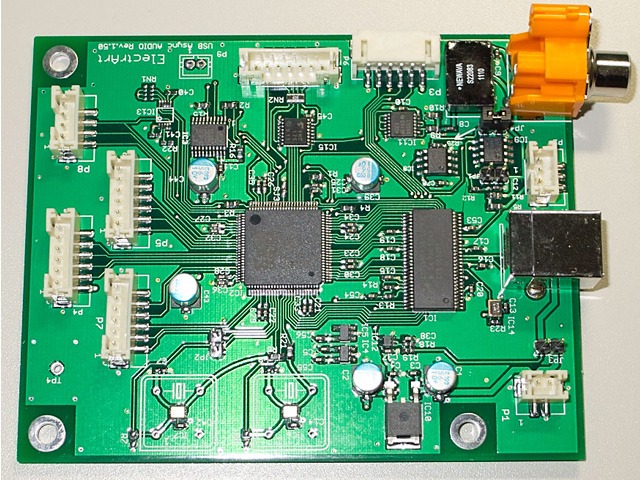Hi Bunpei,
Thank you very much for explanation.
With best regards,
Andrey
They say nothing about ASIO "genuine" DSD bitstream compatibility. They just say an ASIO driver on Windows supports up to PCM 192 kHz. DoP up to DSD128 is supported.
Yes, I2S/DSD digital output is available. I have connected it to TPA Buffalo II DAC.
Bunpei
Thank you very much for explanation.
With best regards,
Andrey
@Gahlord: You might also find this card interesting:
USB Audio - RigiSystems AG
It supports all 24 bit & 32 bit sample frequencies up to 384 kHz (24 bits) and 352.4 kHz (32 bits) both in and out and at the same time with low latency (~6 ms). Additionally, it supports DSD up to 128fs also in and out. Possibly also DxD but I haven't been able to find out about this. Altogether up to 49 Mbps both ways at the same time for one card.
The documentation on their website is not consistent about the frequencies supported but I communicated with the most helpful designer about the specs. To ensure continuous A/D sampling he also recommends an Intel chipset based computer.
I'm interested in buying a card myself so just in case you or somebody else takes an interest in the card I'd appreciate being in on a buy, maybe set up a mutual buy.
Greetings,
Jesper
P.S.: Ok, so now I'm opening the bottle ... I may/might be mistaken about this but there might be a chance of customizing the card to accept DSD*512 both ways, i.e. in and out. It would require custom programming to do so which probably costs a bit (let's assume ~USD 6500) but if enough people is interested it could be "affordable". It would allow for DSD playback/recording at 22.579 and 24.576 MHz.... Any interest?
USB Audio - RigiSystems AG
It supports all 24 bit & 32 bit sample frequencies up to 384 kHz (24 bits) and 352.4 kHz (32 bits) both in and out and at the same time with low latency (~6 ms). Additionally, it supports DSD up to 128fs also in and out. Possibly also DxD but I haven't been able to find out about this. Altogether up to 49 Mbps both ways at the same time for one card.
The documentation on their website is not consistent about the frequencies supported but I communicated with the most helpful designer about the specs. To ensure continuous A/D sampling he also recommends an Intel chipset based computer.
I'm interested in buying a card myself so just in case you or somebody else takes an interest in the card I'd appreciate being in on a buy, maybe set up a mutual buy.
Greetings,
Jesper
P.S.: Ok, so now I'm opening the bottle ... I may/might be mistaken about this but there might be a chance of customizing the card to accept DSD*512 both ways, i.e. in and out. It would require custom programming to do so which probably costs a bit (let's assume ~USD 6500) but if enough people is interested it could be "affordable". It would allow for DSD playback/recording at 22.579 and 24.576 MHz.... Any interest?
Last edited:
... I may/might be mistaken about this but there might be a chance of customizing the card to accept DSD*512 both ways, i.e. in and out.
Hi, Jesper,
How do you prepare an ADC (Delta-sigma modulator) for DSD512?
For DSD256, some are available. But for DSD512? I have no idea.
Bunpei
Hi Bunpei,
Well, I don't know of any DSD512 converters either but I hope to either:
- make a discrete delta-sigma converter as part of a collaboration (preferred).
Or ...
- use the ADS1204 from Texas Instruments, although probably at 256fs.
http://www.ti.com/lit/ds/symlink/ads1204.pdf
The ADS1204 is not an audio chip as such but it's a "pure" second-order delta-sigma modulator that outputs a bitstream and allows for up to 16 MHz sampling frequency. I prefer lower order modulators as their frequency band cut-off slopes are less steep than the higher order modulators. If you look at this datasheet then please note that the data shown is for a sinc3 filter and it could be better with another filter (I would use no digital filter at all except when playing back where a second order analog filter would give an approximately 111 dB reduction of modulator noise at 50 kHz).
Also the second-order modulator can be implemented in a single modulator stage whereas higher orders need more stages (if I remember correctly). Thus, a simple, yet highly optimized circuitry could be possible with a second-order modulator - either a discrete circuitry as part of a collaboration or possibly within the ADS1204.
My sources for delta-sigma modulator designs are some but mostly:
Delta-sigma data converters: Theory, Design & Simulation, Steven R. Norsworthy & Richard Schreier. Goes a bit over my head but as far as I understand considered a very good book on ds-converters.
Uwe Beis: An Introduction to Delta Sigma Converters:
An Introduction to Delta Sigma Converters (see middle of the page for second order converters and for SNR for various order modulators)
Grimm Audio's white paper by Bruno Putzeys (of Hypex.nl) on some of their inspiration for building their AD-1 discrete DSD A/D converter:
http://www.grimmaudio.com/whitepapers/discrete ad converter.pdf
There's also other information on their website about jitter etc.
And then, not last nor least, Bruno Putzeys most kindly outlined for me a practical way of building a discrete A/D converter including what to look for in a comparator, operational amplifier, CMOS flip/flop and latch. I have attached this paper to this post ....
What I'd like to do is to build a delta-sigma modulator (a/d converter) of second order and preferably of a "single-ended" configuration, i.e. without a balanced or differential configuration (if possible but I guess differential cannot be avoided). As simple as possible and using the experience gathered from the sound of single-ended amplifiers - transistors or tubes.
As simple as possible also is the reason why I hesitate to use the Arda AT1201. It converts from a multibit to single-bit DSD signal and my guess would be that this is audible.
I believe a first order modulator would sound best but to get a reasonable SNR the second order modulator is more practically feasible. According to Uwe Beis a first order modulator at 512fs sampling rate would give about 80 dB SNR.
Second order modulator because, theoretically, it allows for about 108/122 dB SNR 256fs/512fs and also can be a fairly simple circuitry with not too steep cut-off slopes, as mentioned. Although theoretically the switched capacitor modulator is less sensitive to jitter I'd actually prefer to make it a continuous time configuration which is what I understand Grimm Audio has also done, although their modulator to my knowledge is a 5th order.
However, I don't know how to calculate the corner frequencies for the modulators so I am most interested in finding collaboration with someone/more people who can do that and could be interested in building such a modulator. If that is not possible I'll try out the ADS1204 at 256 fs and also at 512fs - to see if it works at these frequencies.
For your information I've also just bought the rigisystems USBPAL in/out card. As I understand from its designer it should work (more or less for sure) up to 256fs with one-bit signals both ways. This also means that I won't be buying the Amanero card for now as it "only" goes one way - but nevertheless looks very interesting.
Hope this may help clarify your question
Greetings,
Jesper
How do you prepare an ADC (Delta-sigma modulator) for DSD512?
For DSD256, some are available. But for DSD512? I have no idea.
Well, I don't know of any DSD512 converters either but I hope to either:
- make a discrete delta-sigma converter as part of a collaboration (preferred).
Or ...
- use the ADS1204 from Texas Instruments, although probably at 256fs.
http://www.ti.com/lit/ds/symlink/ads1204.pdf
The ADS1204 is not an audio chip as such but it's a "pure" second-order delta-sigma modulator that outputs a bitstream and allows for up to 16 MHz sampling frequency. I prefer lower order modulators as their frequency band cut-off slopes are less steep than the higher order modulators. If you look at this datasheet then please note that the data shown is for a sinc3 filter and it could be better with another filter (I would use no digital filter at all except when playing back where a second order analog filter would give an approximately 111 dB reduction of modulator noise at 50 kHz).
Also the second-order modulator can be implemented in a single modulator stage whereas higher orders need more stages (if I remember correctly). Thus, a simple, yet highly optimized circuitry could be possible with a second-order modulator - either a discrete circuitry as part of a collaboration or possibly within the ADS1204.
My sources for delta-sigma modulator designs are some but mostly:
Delta-sigma data converters: Theory, Design & Simulation, Steven R. Norsworthy & Richard Schreier. Goes a bit over my head but as far as I understand considered a very good book on ds-converters.
Uwe Beis: An Introduction to Delta Sigma Converters:
An Introduction to Delta Sigma Converters (see middle of the page for second order converters and for SNR for various order modulators)
Grimm Audio's white paper by Bruno Putzeys (of Hypex.nl) on some of their inspiration for building their AD-1 discrete DSD A/D converter:
http://www.grimmaudio.com/whitepapers/discrete ad converter.pdf
There's also other information on their website about jitter etc.
And then, not last nor least, Bruno Putzeys most kindly outlined for me a practical way of building a discrete A/D converter including what to look for in a comparator, operational amplifier, CMOS flip/flop and latch. I have attached this paper to this post ....
What I'd like to do is to build a delta-sigma modulator (a/d converter) of second order and preferably of a "single-ended" configuration, i.e. without a balanced or differential configuration (if possible but I guess differential cannot be avoided). As simple as possible and using the experience gathered from the sound of single-ended amplifiers - transistors or tubes.
As simple as possible also is the reason why I hesitate to use the Arda AT1201. It converts from a multibit to single-bit DSD signal and my guess would be that this is audible.
I believe a first order modulator would sound best but to get a reasonable SNR the second order modulator is more practically feasible. According to Uwe Beis a first order modulator at 512fs sampling rate would give about 80 dB SNR.
Second order modulator because, theoretically, it allows for about 108/122 dB SNR 256fs/512fs and also can be a fairly simple circuitry with not too steep cut-off slopes, as mentioned. Although theoretically the switched capacitor modulator is less sensitive to jitter I'd actually prefer to make it a continuous time configuration which is what I understand Grimm Audio has also done, although their modulator to my knowledge is a 5th order.
However, I don't know how to calculate the corner frequencies for the modulators so I am most interested in finding collaboration with someone/more people who can do that and could be interested in building such a modulator. If that is not possible I'll try out the ADS1204 at 256 fs and also at 512fs - to see if it works at these frequencies.
For your information I've also just bought the rigisystems USBPAL in/out card. As I understand from its designer it should work (more or less for sure) up to 256fs with one-bit signals both ways. This also means that I won't be buying the Amanero card for now as it "only" goes one way - but nevertheless looks very interesting.
Hope this may help clarify your question
Greetings,
Jesper
Attachments
Last edited:
What a long post of rich contents!
I understood your interest comprehensively. However, I failed to have a basic information on your backgrounds and skills.
The designer and builder of the USB Dual Audio board, ElectrArt, have two ARDA AT1201 chips and he might be developing his own DSD256 recorder now.
If he presented any progress for the recorder on his blog page, I will introduce it here.
(though I know you hate a multi-bit delta-sigma modulator)
I understood your interest comprehensively. However, I failed to have a basic information on your backgrounds and skills.
The designer and builder of the USB Dual Audio board, ElectrArt, have two ARDA AT1201 chips and he might be developing his own DSD256 recorder now.
If he presented any progress for the recorder on his blog page, I will introduce it here.
(though I know you hate a multi-bit delta-sigma modulator)
The designer and builder of the USB Dual Audio board, ElectrArt, have two ARDA AT1201 chips and he might be developing his own DSD256 recorder now.
If he presented any progress for the recorder on his blog page, I will introduce it here.
(though I know you hate a multi-bit delta-sigma modulator)
Thank you for intresting information about DSD256 in Japan, I have read all you posts and try to read the ElectrArt blog. The device PCM2DSD256 excite me very much there. The process of transfering the PCM to DSD256 using software is complicated and long. If it will be possible to do on fly it will be the realy bomb! What do you think and knew about this device? What about plans of the ElectrArt to sell it?
... The device PCM2DSD256 excite me very much there. The process of transfering the PCM to DSD256 using software is complicated and long. If it will be possible to do on fly it will be the realy bomb! What do you think and knew about this device? What about plans of the ElectrArt to sell it?
ElectrArt is developing his original hardware-based PCM2DSD256 converter.
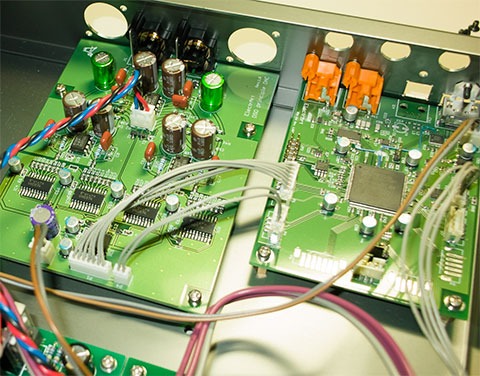
The board on the right side is the PCM2DSD256 conversion board.
Input: S/PDIF, I2S PCM 44.1kHz/16bit, 48kHz/16bit - 176.4kHz/24bit, 192kHz/24bit
Output: DSD256(11.2896MHz, 12.288MHz; DSDL, DSDR, DSDCLK, MCLK( ~ 90.3168MHz, 98.304MHz)
He has built a S/PDIF decoder , a Digital FIR upsampler and a Delta-Sigma Modulator into one FPGA chip (Xylinx Spartan 6 or Altera Cyclone III)
He is expected to release the board as a finished board kit for DIY users. However, no finalized release plan is announced yet.
The board on the left side is his "DAC" board. It includes an Analog FIR and an Analog Filtering OP amp circuit (Stereo balanced analog output).
The combination runs as his proprietary "DAC".
Bunpei
Last edited:
... Are you planing to try it? Your opinion will be very important to me. Is it big differences of sound to the software conversion and to native PCM? ...
I will try it when the board becomes available for beta-testers.
I have listened to his first prototype connecting it to Buffalo II DAC in synchronous master clocking scheme. Upper stream transport was ElectrArt's USB Dual Audio board. I played 44.1kHz/16bit PCM sources on PC and listened hardware converted DSD256 sounds. My first impression was "Oh, it sounds as DSD256 does sound! Better than the original 44.1kHz/16bit PCM direct play!"
Then I listened DSD256 sources using ElectrArt's proprietary player software "PlayAudio". The DSD256 sources were converted from 44.1kHz/16bit PCM using SONY DSD Direct on PC. I felt the latter, software converted ones, did sound better than hardware converted ones.
Please remember that it's just a result of his first prototype that has never appeared in this thread.
Hi Bunpei,
By chance do you know what's the value of R1-R8 resistors?
Has anyone compared with FIR inside DSD1794?
Regards
By chance do you know what's the value of R1-R8 resistors?
Has anyone compared with FIR inside DSD1794?
Regards
His first design is this;
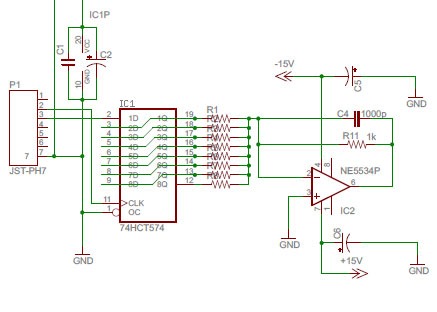
The prototype of filtering board appears at the upper left.
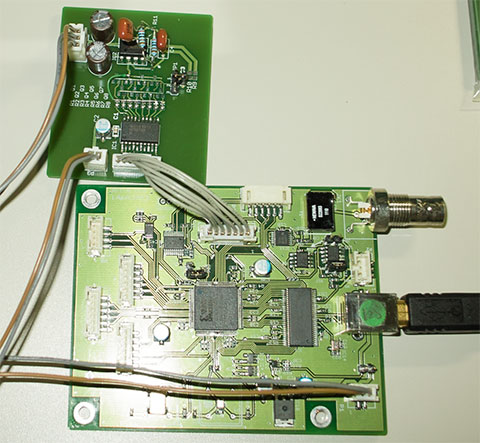
The prototype has evolved to the full balance board shown in the previous post.
Last edited:
iam not a diy expert but an enthusuasist.iam very much interested in dsd256 playback.the ElectrArt's USB DUAL AUDIO(UDA) board looks promising for the purpose.could anyone kindly explain what is needed, apart this, to play dsd256 files from my computer, finally the output being fed to my cary audio pre-amplifier .
... By chance do you know what's the value of R1-R8 resistors?
Has anyone compared with FIR inside DSD1794? ...
I have watched his blog page for about 10 days. He has not yet disclosed R values in his 8 tap FIR circuit. He said that 8 taps are not enough
for achieving such a performance that DSD1794 has.
iam not a diy expert but an enthusuasist.iam very much interested in dsd256 playback.the ElectrArt's USB DUAL AUDIO(UDA) board looks promising for the purpose.could anyone kindly explain what is needed, apart this, to play dsd256 files from my computer, finally the output being fed to my cary audio pre-amplifier .
Oh, no one gives any reply to him. Then, I will.
Within my limited knowledge, there are two DIY oriented board kit products that support DSD256 play from PC.
1. ElectrArt's USB DUAL AUDIO(UDA)
2. ExaDevices exaU2I (DSD512 is supported also)
Both kits have USB input and DSD-raw digital signal output. They provide each proprietary player program on Windows, PlayAudio for UDA and LoTech Player for exaU2I. You can't use such generic player as foobar 2000 or JRiver.
Both require USB 2.0 high speed interface.
You need to prepare your DAC device with DSD256-ready DAC module. Possible DSD256-ready DAC modules are;
A. ESS ES9018
B. TI Burr-Brown PCM/DSD 179x series DAC chip of advanced segment architecture
C. Niigata Seimitsu FN1242A
D. a simple home-brew LCR filter
If you allow a certain level of residual digital-noises, the option D is the easiest.
I hope this information may encourage you enough.
I will try it when the board becomes available for beta-testers.
ElectrArt announced an update for his PCM2DSD converter kit on his blog page (in Japanese).
ElectrArt?Digital Audio???
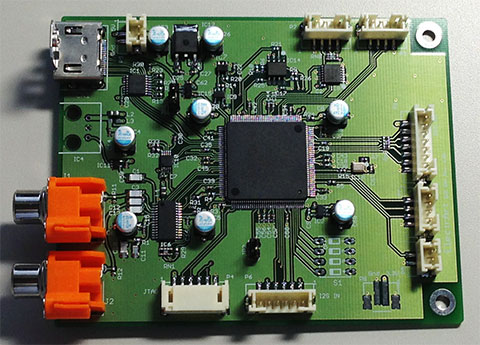
Bunpei regards the board as his proprietary "Delta-sigma DAC" device because Bunpei could listened a high quality music by connecting a simple home-brew LCR filter to the DSD output of the board.
The board has various input;
1. two S/PDIF RCA and one S/PDIF TOSLINK optical
2. I2S via PS-Audio standard HDMI connector
3. I2S via 7 pins connector
Output;
1. DSD256 for all input [normal mode]
2. DSD256 for 44.1 & 48 kHz PCM and DSD512 for PCM of 88.1 kHz or higher
3. PCM or DSD on input without conversion. [Bypass mode]
One of two types of delta-sigma modulators can be selected.
One of two types of output filters, fast and slow can be selected.
The board can be integrated easily with his UDA board at an input side and his DSD1794A DAC board at an output side.
He confirmed DSD512 can be played without problem on DSD1794A DAC.
The kit will be released early next month if possible. He will accept orders through his web page.
The final price is not decided yet. However, he is making his efforts to keep it in the same price range of his UDA board kit.
USB High speed Line Isolation using Adnaco Product
ElectrArt's USB DUAL AUDIO board includes no galvanic isolation circuits.
I have tried "SuperSpeed USB 3.0 Over Fiber Optic Expansion System" made by Adnaco, a Canadian company, to evaluate the effect of USB line isolation.

My preliminary impression is the isolation brings a certain level of good effect on the quality of resulting sounds.
The system can provide a galvanic isolation of electrical grounds between external USB Audio devices and PC by achieving a digital data transfer over a pair of optical fibers of computer data communication grade.
Its primary intended use might be for factory automation or medical electronics where a long bus extension or a complete galvanic isolation is required.
The system consists three major parts.
1. Extension card for PCI Express bus in PC
2. Multi-mode optical fiber
3. Two port USB 3.0 interface unit with an external power adapter
As the two USB ports supports USB 3.0, data transfer on USB 2.0 High speed (480Mbps) was achieved without any problem and I could enjoy DSD256 or PCM 192kHz/24bit stereo plays.
This system does not expand any USB 3.0 signals on PC but expands PCI Express bus signals based on their proprietary technology in a hardware domain. Therefore, no special driver software is required for the PCI Express bus card.
Only a driver for TI USB 3.0 compatible USB interface chip built in the interface unit hooked at the end of optical fibers needs to be installed. The driver software is provided by TI.
The expansion system is completely transparent to any audio application level traffics. In other words, any software applications for audio play do not know that a pair of optical fibers are inserted in the connection.
One big limitation is that this system is not applicable to PCs of no PCI Express bus.
An audiophile grade power supply can be connected to the USB 3.0 interface unit. The actual draw is 0.5 A for +5.0 V DC.
The price of the system is almost or slightly over 400 USD including tax and shipping charge. Some people may think it's too expensive while some people may think it's worth paying. In my case, I thought it was a good product to buy.
ElectrArt's USB DUAL AUDIO board includes no galvanic isolation circuits.
I have tried "SuperSpeed USB 3.0 Over Fiber Optic Expansion System" made by Adnaco, a Canadian company, to evaluate the effect of USB line isolation.

My preliminary impression is the isolation brings a certain level of good effect on the quality of resulting sounds.
The system can provide a galvanic isolation of electrical grounds between external USB Audio devices and PC by achieving a digital data transfer over a pair of optical fibers of computer data communication grade.
Its primary intended use might be for factory automation or medical electronics where a long bus extension or a complete galvanic isolation is required.
The system consists three major parts.
1. Extension card for PCI Express bus in PC
2. Multi-mode optical fiber
3. Two port USB 3.0 interface unit with an external power adapter
As the two USB ports supports USB 3.0, data transfer on USB 2.0 High speed (480Mbps) was achieved without any problem and I could enjoy DSD256 or PCM 192kHz/24bit stereo plays.
This system does not expand any USB 3.0 signals on PC but expands PCI Express bus signals based on their proprietary technology in a hardware domain. Therefore, no special driver software is required for the PCI Express bus card.
Only a driver for TI USB 3.0 compatible USB interface chip built in the interface unit hooked at the end of optical fibers needs to be installed. The driver software is provided by TI.
The expansion system is completely transparent to any audio application level traffics. In other words, any software applications for audio play do not know that a pair of optical fibers are inserted in the connection.
One big limitation is that this system is not applicable to PCs of no PCI Express bus.
An audiophile grade power supply can be connected to the USB 3.0 interface unit. The actual draw is 0.5 A for +5.0 V DC.
The price of the system is almost or slightly over 400 USD including tax and shipping charge. Some people may think it's too expensive while some people may think it's worth paying. In my case, I thought it was a good product to buy.
Hi Bunpei,
thank you for sharing your experience with the USB-isolator! I have been looking for such a device, and I think that this isolator is what I need
I work in the medical industry (hospital), and 400 USD is cheap. I just bought a USB1 isolator with medical approval, for the pridcut I am developing, and it cost 1200 USD!
Best regards,
S
thank you for sharing your experience with the USB-isolator! I have been looking for such a device, and I think that this isolator is what I need
I work in the medical industry (hospital), and 400 USD is cheap. I just bought a USB1 isolator with medical approval, for the pridcut I am developing, and it cost 1200 USD!
Best regards,
S
ElectrArt's USB DUAL AUDIO board includes no galvanic isolation circuits.
I have tried "SuperSpeed USB 3.0 Over Fiber Optic Expansion System" made by Adnaco, a Canadian company, to evaluate the effect of USB line isolation.

My preliminary impression is the isolation brings a certain level of good effect on the quality of resulting sounds.
The system can provide a galvanic isolation of electrical grounds between external USB Audio devices and PC by achieving a digital data transfer over a pair of optical fibers of computer data communication grade.
Its primary intended use might be for factory automation or medical electronics where a long bus extension or a complete galvanic isolation is required.
The system consists three major parts.
1. Extension card for PCI Express bus in PC
2. Multi-mode optical fiber
3. Two port USB 3.0 interface unit with an external power adapter
As the two USB ports supports USB 3.0, data transfer on USB 2.0 High speed (480Mbps) was achieved without any problem and I could enjoy DSD256 or PCM 192kHz/24bit stereo plays.
This system does not expand any USB 3.0 signals on PC but expands PCI Express bus signals based on their proprietary technology in a hardware domain. Therefore, no special driver software is required for the PCI Express bus card.
Only a driver for TI USB 3.0 compatible USB interface chip built in the interface unit hooked at the end of optical fibers needs to be installed. The driver software is provided by TI.
The expansion system is completely transparent to any audio application level traffics. In other words, any software applications for audio play do not know that a pair of optical fibers are inserted in the connection.
One big limitation is that this system is not applicable to PCs of no PCI Express bus.
An audiophile grade power supply can be connected to the USB 3.0 interface unit. The actual draw is 0.5 A for +5.0 V DC.
The price of the system is almost or slightly over 400 USD including tax and shipping charge. Some people may think it's too expensive while some people may think it's worth paying. In my case, I thought it was a good product to buy.
Hi, staccatiss,
I appreciate your comment very much! It's my pleasure.
By the way, an idea hit me to use this device with a notebook type PC.
Many recent notebook type PCs have an "ExpressCard/34" slot.
Here is an adapter for ExpressCard/34 to PCI Express x1.
PE4L ( PCIe Adapter ver2.1 )
This adapter might be used with the PCI Express card of the Adnaco. But I'm not sure as I have not experimented that.
I appreciate your comment very much! It's my pleasure.
By the way, an idea hit me to use this device with a notebook type PC.
Many recent notebook type PCs have an "ExpressCard/34" slot.
Here is an adapter for ExpressCard/34 to PCI Express x1.
PE4L ( PCIe Adapter ver2.1 )
This adapter might be used with the PCI Express card of the Adnaco. But I'm not sure as I have not experimented that.
I have watched his blog page for about 10 days. He has not yet disclosed R values in his 8 tap FIR circuit. He said that 8 taps are not enough
for achieving such a performance that DSD1794 has.
ElectrArt presented his final version of "DSD Principle DAC" on his blog page.
ElectrArt?Digital Audio??? ???????? 1bit delta sigma DAC (In Japanese)
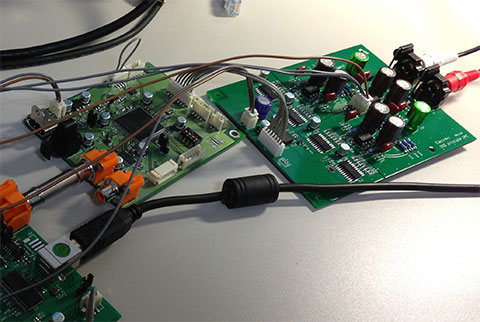
The dark green board at the upper right is his "DSD Principle DAC".
Its schematic is here.
He says the board has achieved a filtering performance comparable to DSD1794A.
To my regret, he has kept the R1-R8 values non-disclosure on the schematic.
He may distribute a bare board.
- Status
- This old topic is closed. If you want to reopen this topic, contact a moderator using the "Report Post" button.
- Home
- Source & Line
- Digital Source
- USB DSD DAC and ADC by ElectrArt
